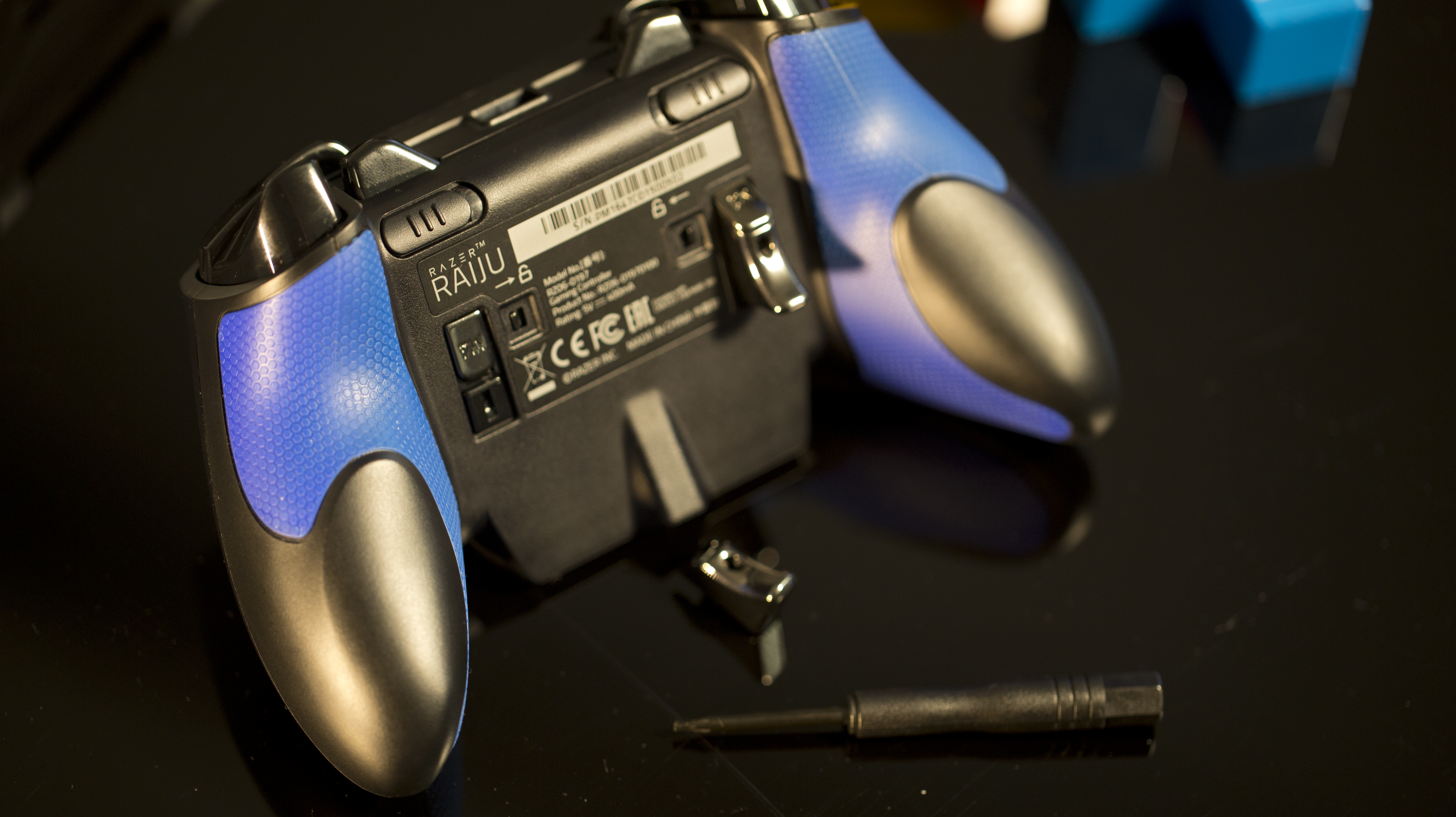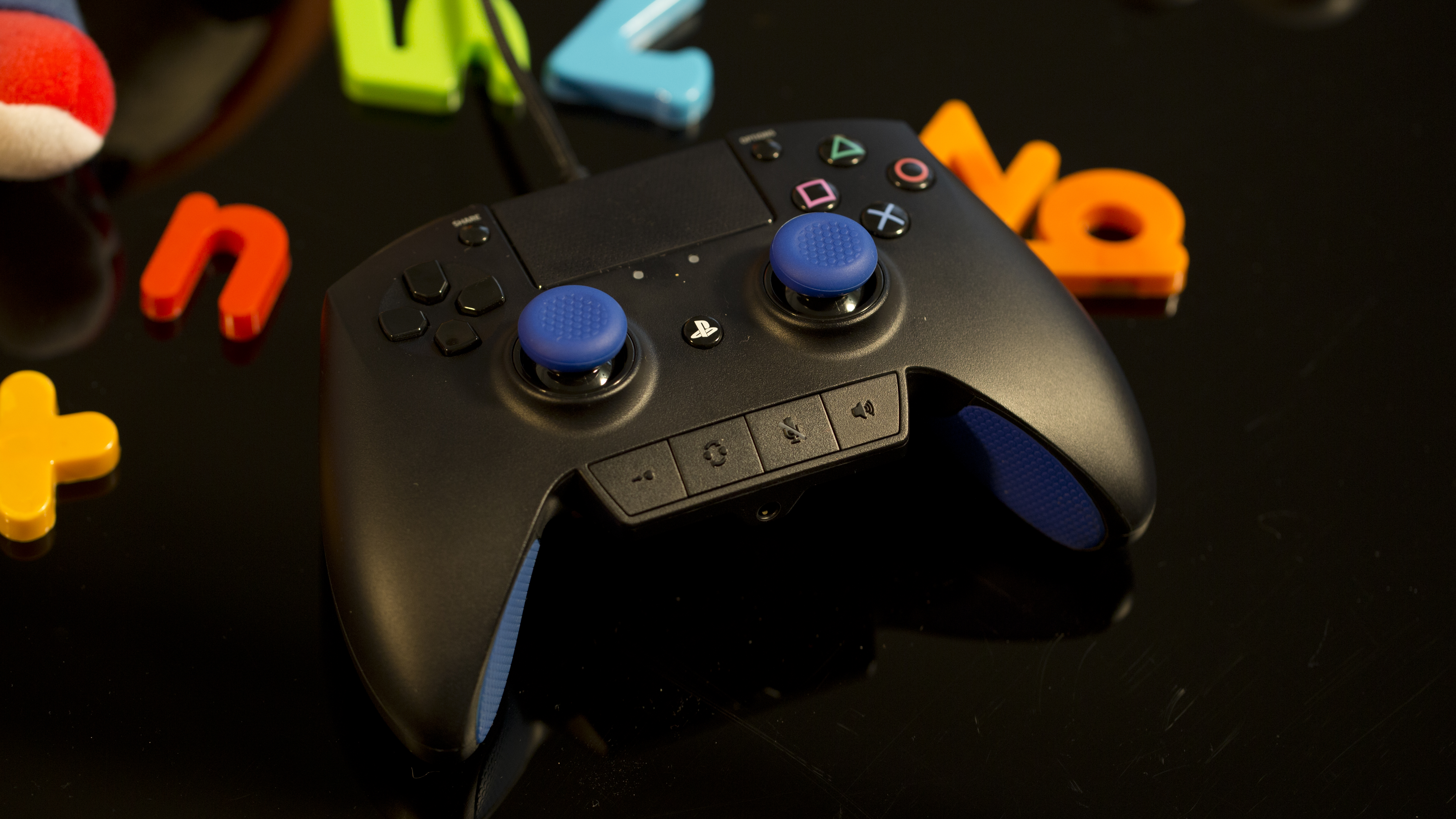TechRadar Verdict
Its customisable buttons might make this a great controller to use in games where you need to keep your thumbs on the sticks at all times, but its lack of wireless functionality means that the Raiju might not be about to become your everyday gamepad.
Pros
- +
Customisable buttons work great
- +
Face buttons are nicely tactile
- +
Headphone volume control buttons
Cons
- -
No wireless
- -
Easy to accidentally press back triggers
- -
D-pad not perfect for every genre
Why you can trust TechRadar
Third party controllers have had a bad reputation in the past.
It’s not that they’ve been particularly bad, but they’ve been the kinds of controllers that have made you realise just how amazingly designed Sony, Microsoft and Nintendo’s own controllers have been.
As a case in point, the wired Xbox 360 controller which we bought second-hand over six years ago is still in perfect working order despite the daily abuse we put it through.
The Razer Raiju wants to change all that. It represents Razer’s attempt to improve upon Sony’s standard PS4 controller, the DualShock 4, and introduces a couple of useful features like additional programmable buttons and adjustable triggers.
How useful you end up finding the controller will depend on the kinds of genres of games you play. None of the controller's additions make it worse than the standard controller, but certain genres won’t see as much of a benefit from them, and this might just be enough to make you want to stick with your existing controller.
Design
Although it’s a PS4 controller, the Razer Raiju is very similar in shape to Microsoft’s Xbox One controller.
It’s much bigger than the standard PS4 joypad, and is very comfortable if you’ve got bigger hands, although if your hands are on the smaller side (no jokes here please) you might find the analogue sticks a little bit of a stretch to reach.
Below the two analogue sticks are a series of four buttons to allow you to switch between available profiles (more on these later), as well as a mic mute and volume control button.

We really appreciated these extra buttons, since having to dig through the PS4’s menus to adjust volume can be a pain. They make the bottom of the controller look a touch less sleek, but we’re happy with the extra functionality they provide.
On the top of the controller are a couple of sliders, which allow you to select how much travel there is in the L2 and R2 buttons. A shorter travel is better if you want to be able to quickly completely depress the trigger quickly, while a longer travel is better if you want to be able to more easily half-press the trigger.
We found a shorter travel better for shooters, where it allowed us to quickly fire off multiple shots, whereas the longer travel was more suited to driving games, where it allowed us finer control over the car’s acceleration and braking.

The Razer Raiju is a wired-only controller, whereas the standard PS4 controller can be used wirelessly. Depending on your attitude towards lag this might be a price you’re willing to pay, but we weren’t happy with the inconvenience this caused.
It should also be noted that the newer DualShock 4 included with the PS4 Slim and PS4 Pro is also able to be used as a wired controller if lag is a concern. The original PS4’s controller could be used while it was plugged in, but it would continue to transmit its data wirelessly, and use the USB connection for charging only.
Around the rear of the controller is where the real action happens though.

The Razer Raiju has a total of four extra triggers which you can program to your liking.
There are two extra bumpers, located next to the controller’s standard triggers, and there are also two extra triggers, located on the underside of the controller.
Each of the four controllers can be programmed to take the place of any other button on the controller, meaning that you can, for example, remap an R3 melee attack to one of the extra triggers to avoid throwing your aim off by having to press down on the analogue stick.

You can also map any directional or face button to the triggers, to allow you to press them without having to take your fingers off the joysticks.
Nicely you’re able to remove the bottom two triggers with an included screw, although unfortunately your fingers might still occasionally accidentally press them despite the trigger portion of the button being removed.
A final feature is the grippy rubber which can be found on top of the thumb-grips which you’re able to remove. We’re not entirely sure why anyone would want to do so however, as the stock thumbstick is very slippery without the grip, but if you end up using the controller for years and wearing away the top of the stick, it might be nice down the line to be able to replace it.
Performance
As well as its additional features, the Razer Raiju also feels a lot different to use than the PS4’s original DualShock 4.
If you’ve ever spent any time with a mechanical keyboard, this is probably the closest comparison we can draw.
The Raiju’s face buttons feel very clicky, like a mechanical keyboard compared to the DualShock 4’s more membrane-style buttons.
The effect of this is to make it very obvious when a button has been pressed, and the clicky feedback is satisfying.
We thought the audible clicking would get annoying, but we were able to tune it out almost immediately.

The directional-pad on the left of the controller will be more divisive, and definitely suits some games over others.
The reason for this is that the Raiju’s directional pad is made up of four separate buttons, as opposed to the single rocking pad that makes up the DualShock 4’s.
A rocking pad means that when you press the right directional button, the left button will raise up, because they consist of the same bit of plastic within the housing.
This works very well in games where the four directions are assigned to four separate functions, since you’re much less likely to accidentally press the wrong button. In a game like Battlefield 1 for example, this can mean the difference between using an accessory and switching your gadget, and it’s nice having the buttons clearly separated.

But separate buttons are much less helpful in games where they’re used for directional movement, since they make it much more difficult to move diagonally.
This also means that the controller isn’t ideal for fighting games, which often rely on quick quarter-circles being performed on the D-pad.
The additional buttons are well-placed and versatile and, in fact, it’s surprising how quickly you start to take the extra buttons for granted. Having to take your finger off the left thumbstick to switch weapons feels inefficient once you’ve gotten used to being able to tap the rear trigger with your ring-finger, and the ability to quickly melee an opponent without throwing off your aim is great.

But for games that don’t rely on you constantly having your thumbs on the sticks, the benefit of these extra buttons is much more limited. There’s no ability to bind them to a collection of buttons rather than just single ones, and in these games there’s little benefit to them.
Finally, we should address the fact that the controller isn’t wireless. The supplied USB cable is long enough that it should reach across all but the most cavernous of living rooms, but it’s still a shame to not be able to go wireless.
This, in addition to the controller’s inability to turn the console on using the central PS button, made it feel at times as though we were using a retro console rather than a modern PS4. It wasn’t the worse thing in the world having to walk over to our console to turn it on, but it’s something we’re not used to having to do.
A final point we’d like to make concerns the controller’s headphone-out port. While we really appreciated the volume controls located on the controller, there was a fair amount of background hiss from our headphones when the signal should have been quiet.
It wouldn’t be an issue in a noisy shooter, but when we were playing a quieter single-player game, it was an annoying distraction.

We liked
The extra buttons are great for games where you want your fingers on the thumbsticks at all times. Not having to move your thumbs is a convenience you’ll quickly get used to, and the method for pairing the buttons is quick and easy to do.
The face buttons have a nice click to them, making it easy to feel the exact point when they’ve been pressed, and being able to adjust trigger travel is also great.
The overall size and weight of the controller was nice, and having volume controls located on the controller itself is great.
We disliked
We understand the lag issues involved with wireless connectivity, but we would have at least liked to have had the option of using it in this configuration. Being forced to trail a cable across our living room doesn’t feel very 2016.
The triggers on the underside of the controller are easy to accidentally press, even when you remove the triggers.
The D-pad isn’t great if you need to use it for movement or fighting game combos.
Final Verdict
The Razer Raiju is a controller made with specific genres of games in mind.
If you use it to play first- or third-person shooters, then you’ll quickly find the extra buttons nigh-on essential because of how you can use them without taking your fingers off the thumbsticks, and the adjustable triggers mean you can press them that much quicker. The Raiju feels great when you use it to play these games.
But the controller doesn’t fare as well when it comes to other genres, where the extra buttons are less useful, and you might find yourself growing frustrated by the lack of wireless functionality.
What this means is that while the Raiju is an excellent tool for a specific job, it’s unlikely to replace your trusty DualShock 4 for everyday use.
Jon Porter is the ex-Home Technology Writer for TechRadar. He has also previously written for Practical Photoshop, Trusted Reviews, Inside Higher Ed, Al Bawaba, Gizmodo UK, Genetic Literacy Project, Via Satellite, Real Homes and Plant Services Magazine, and you can now find him writing for The Verge.

